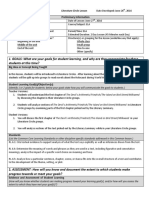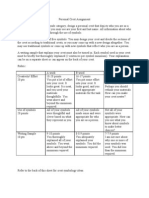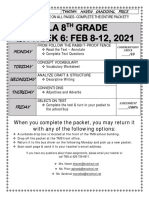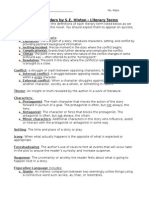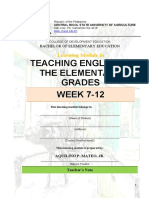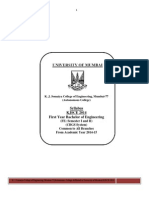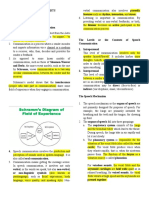Walk Two Moons WebQuest Lesson Plan
Walk Two Moons WebQuest Lesson Plan
Uploaded by
Emily LimingCopyright:
Available Formats
Walk Two Moons WebQuest Lesson Plan
Walk Two Moons WebQuest Lesson Plan
Uploaded by
Emily LimingCopyright
Available Formats
Share this document
Did you find this document useful?
Is this content inappropriate?
Copyright:
Available Formats
Walk Two Moons WebQuest Lesson Plan
Walk Two Moons WebQuest Lesson Plan
Uploaded by
Emily LimingCopyright:
Available Formats
KEERAN SCHOOL OF EDUCATION LESSON PLAN
Teacher: School: Subject area: Primary: Reading Secondary: Writing, Geography, Personal Wellness 11-12 6 Emily Liming ID: Date of Observation: District:
Ages of students: Grade level: Total number of students: Title of Lesson Plan: Title of Unit:
Type of classroom # of IEP # of 504 # of GSSP # of ELL
Traditional 0 0 0 0
20
Walk Two Moons WebQuest
Walk Two Moons
ACTIONS
Goals, Objectives, & Essential Questions A. Broad Goal: Students will read the book Walk Two Moons in five parts, answering questions in their reading journal and completing WebQuest activities for each section. B. Objectives: 1. Students will take physical descriptions of characters, make a mental picture of what the character looks like, and sketch a portrait of the character based on their description in the book with creativity and 100% accuracy. 2. Given a symbolic name, event, or phrase in the text, students will be able to recognize symbolic meanings and be able to write a response to these symbols. 3. Students will write a short essay to compare and contrast two families in the text and support their points with evidence from the text. 4. Students will be able to read the text, think critically about it, and predict what will happen next. 5. Using the class web site provided, students will follow links to different prescribed web sites. Students will skim sites to answer questions.
6. Students will read an Indian legend, accurately summarize it in correct paragraph form, and creatively respond to it, making text-to-self, text-totext, and text-to-world connections. 7. Students will analyze cryptic messages given to a main character in the story, explain their meanings, and give examples of a time in the story when characters should have followed the messages advice. 8. Given a video of someone reading a poem, students will listen to it; explain its meaning; recall basic facts about the poem; explain its symbolism; recognize metaphors, personification, and parallel structure; and understand vocabulary used in the poem. 9. Students will write a four-paragraph fictional scene that will serve as an alternative ending to the novel. Students will display creativity, write in paragraph form, use correct spelling, avoid grammar mistakes, and use the same point of view and style that is present in the novel.
C. Essential Questions: 1. I can sketch a portrait of a character in Walk Two Moons based on their physical description in the book. 2. I can recognize symbolism in literature I read and can write a response to these symbols. 3. I can write a short essay to compare and contrast two families in the text and support their points with evidence from the text. 4. I can read the text, think critically about it, and predict what will happen next. 5. I can skim an online article to answer questions rather than reading the whole article. 6. I can summarize a short story in correct paragraph form and creatively respond to it, making text-to-self, text-to-text, and text-to-world connections. 7. I can analyze cryptic messages given to a main character in the story, explain their meanings, and give examples of a time in the story when characters should have followed the messages advice. 8. I can listen to a poem; explain its meaning; recall basic facts about the poem; explain its symbolism; recognize metaphors, personification, and parallel structure; and understand vocabulary used in the poem. 9. I can write a four-paragraph fictional scene that will serve as an alternative ending to the novel. I can display creativity, write in paragraph form, use correct spelling, avoid grammar mistakes, and use the same point of view and style that is present in the novel.
Connections A. Primary Lesson Standards: Kentucky Learner Goals & Academic Expectations: 6. Students shall develop their abilities to connect and integrate experiences and new knowledge from all subject matter fields with what they have previously learned and build on past learning experiences to acquire new information through various media sources. AE 1.2 Students make sense of the variety of materials they read. AE 1.16 Students use computers and other kinds of technology to collect, organize, and communicate information and ideas. Core Content for Assessment: T-MS-ICP-S-C2 Students will select and use appropriate technology to collect, analyze and share information National Standards: RL.6.1. Students will cite textual evidence to support analysis of what the text says explicitly as well as inferences drawn from the text. RL.6.2. Determine a theme or central idea of a text and how it is conveyed through particular details; provide a summary of the text distinct from personal opinions or judgments. W.6.1. Write arguments to support claims with clear reasons and relevant evidence. W.6.4. Produce clear and coherent writing in which the development, organization, and style are appropriate to task, purpose, and audience
B. Other Disciplinary Standards: Kentucky Learner Goals & Academic Expectations: 2. Students shall develop their abilities to apply core concepts and principles from mathematics, the sciences, the arts, the humanities, social studies, practical living studies, and vocational studies to what they will encounter throughout their lives.
AE 2.19 Students recognize and understand the relationship between people and geography and apply their knowledge in real-life situations. AE 2.31 Students demonstrate the knowledge and skills they need to remain physically healthy and to accept responsibility for their own physical well-being. Program of Studies: Skills and Concepts Core Content for Assessment: SS-05-4.1.2. Students will use geographic tools to locate and describe major landforms, bodies of water, places and objects in the United States by their absolute location. PL-6-PW-S-PPH2 Students will explore and analyze how an individuals behaviors and choices of diet, exercise and rest affect the body C. Statement Connecting the Standards to Your Objectives: The above standards relate to my objectives because the assignments revolve around teaching these concepts. The Walk Two Moons map activities teach students how to locate places and landforms of a map of the United States. Students meet the health standard by researching cholesterol and the effect of bad cholesterol on the body. Reading and writing activities meet many English standards by asking students to read and listen to literature, analyze symbolism, recognize figures of speech, recognize point of view, create logical arguments, make predictions, and support answers with evidence from the text.
Context 1. Unit a. 5 spread-out days of a three week unit
Differentiation: A. Individual Learning Styles: Variations for: Description of Variation Students read Walk Two Moons silently on their own time. Visual Learners Students answer questions in a colorful, visually attractive journal.
Auditory Learners Kinesthetic Learners
Important sections of Walk Two Moons will be read aloud and discussed in class. In their journal, students answer questions, draw pictures, and place locations on a map. Students use the internet to learn more about topics alluded to in the novel, including cholesterol, Indian legends, and poetry.
B. Multiple Learning Levels: Procedure Step Day 1
2
Blooms Taxonomy
Knowledge, comprehension Knowledge
Depth of Knowledge
1, 2 1
Procedure Step Day 2
2 4
Blooms Taxonomy
Knowledge, comprehension, application Knowledge
Depth of Knowledge
1, 2, 3 1
Procedure Step Day 3
2
Blooms Taxonomy
Knowledge Comprehension
Depth of Knowledge
1, 2 2, 3
5 7
Comprehension, application
Procedure Step Day 4
1 6 7
Blooms Taxonomy
Comprehension, application, analysis Knowledge Knowledge, comprehension
Depth of Knowledge
2 1 1, 2
Procedure Step Day 5
5
Blooms Taxonomy
Knowledge, comprehension, application Synthesis, judgment
Depth of Knowledge
1, 2 4
Real-Life Connections: Students learn how to read, analyze, and respond to articles, literature, and poetry; these are skills that will be used out of school for the rest of their lives. Students learn how to
map out a trip through the United States, something that many of them have probably done before or will do in their lifetime. Students learn practical ways to use the computers and the internet. Students learn how to apply moral lessons from Walk Two Moons by analyzing what would have happened differently if characters would have made wiser choices.
Technology Students manipulate the class WebQuest site and the internet to read articles, perform searches, and watch videos. Procedures (5 days total) Day 1 1. (__3__ min.) Students turn on their computers 2. (__20__ min.) Students answer non-web questions in their reading journal 3. (__2__ min.) Students visit the WebQuest site 4. (__20__ min.) Students visit Day 1 links and answer journal questions from the site. 5. (__5__ min.) Students turn off their computers and return to the classroom. Day 2 1. (__3__ min.) Students turn on their computers 2. (__20__ min.) Students answer non-web questions in their reading journal 3. (__2__ min.) Students visit the WebQuest site 4. (__20__ min.) Students visit Day 1 links and answer journal questions from the site. 5. (__5__ min.) Students turn off their computers and return to the classroom. Day 3 1. (__3__ min.) Students turn on their computers
2. (__10__ min.) Students answer non-web questions in their journal 3. (__5__ min.) Students visit WebQuest site and follow site link to article Turtles Race With Bear 4. (__7__ min.) Students read Turtles Race with Bear Bear 6. (__5__min) Students turn off computers and return to the classroom. 5. (__10__ min.) Students write a paragraph summary of Turtles Race with
7. (__10__ min.) Students write a one-paragrph response to Turtles Race with Bear Day 4 1. (___15__min) Students answer non-web journal questions 2. (__5__ min.) Students turn on computers 3. (__5__ min.) Students visit the WebQuest site and follow link to The Tide Rises, the Tide Falls video 4. (3 min) Students view video 5. (5 min) Students read article explaining the symbolism in The Tide Rises, the Tide Falls 6. (9 min) Students look up definition to 3 vocabulary words on Dictionary.com 7. (5 min) Students answer journal questions based on the poem 8. (3 min) Student turn off computers and return to the classroom Day 5 1. Students turn on computers 2. (5 min) Students visit WebQuest site and follow link to Sharon Creech 60 second recap 3. (3 min) Students watch video to refresh their memory on everything that happens over the course of the novel. 4. (5 min) Students return to the classroom 5. (15 min) Students complete map activity in groups 6. (20 min) Students use the remaining time in class to begin the creative writing assignment in their journal. Whatever they dont finish in class is homework. IMPACT Prepared after the lesson is taught. Reflection/Analysis of Teaching and Learning REFINEMENT - Prepared after the lesson is taught. Lesson Extension/Follow-up
You might also like
- Hobbit Day Event KitDocument23 pagesHobbit Day Event KitHoughton Mifflin HarcourtNo ratings yet
- School Paper Action PlanDocument2 pagesSchool Paper Action PlanGoldwin Adi93% (14)
- Crucible UnitDocument3 pagesCrucible UnitJerad DampsonNo ratings yet
- Te 408 Lesson Plan - If I Ever Get Out of HereDocument3 pagesTe 408 Lesson Plan - If I Ever Get Out of Hereapi-285510782No ratings yet
- TKMB Lesson Plan Honors English IDocument89 pagesTKMB Lesson Plan Honors English Iapi-272665425100% (1)
- Walk Two MoonsDocument10 pagesWalk Two MoonsMichele Carr Clemmensen50% (2)
- Unwind Final TestDocument4 pagesUnwind Final TestDrew LandryNo ratings yet
- The Development of Friendship Between Stanley and ZeroDocument2 pagesThe Development of Friendship Between Stanley and Zeromoongmoong100% (5)
- Literature Choice BoardDocument4 pagesLiterature Choice Boardapi-468581953No ratings yet
- Book Report Sample Paper: Name - DateDocument1 pageBook Report Sample Paper: Name - DateGigih Rizqi AdhiNo ratings yet
- Walk Two Moons Powerpoint IanJordanGageGarrettDocument22 pagesWalk Two Moons Powerpoint IanJordanGageGarretthiyeonNo ratings yet
- Grade 8 English - Outsiders WorksheetsDocument8 pagesGrade 8 English - Outsiders Worksheetsapi-316708057No ratings yet
- 7 8 OutsidersDocument16 pages7 8 Outsidersorchid_mNo ratings yet
- Walk Two Moons, Study QuestionsDocument2 pagesWalk Two Moons, Study QuestionshskyaNo ratings yet
- Walk Two Moons, Themes Motifs Symbol. Study NotesDocument3 pagesWalk Two Moons, Themes Motifs Symbol. Study NoteshskyaNo ratings yet
- Walk Two Moons 4MADocument16 pagesWalk Two Moons 4MALKNo ratings yet
- Coraline Fairy Tale ChartDocument3 pagesCoraline Fairy Tale Chartapi-262705251No ratings yet
- Tkam ThemesDocument3 pagesTkam Themesapi-252344608No ratings yet
- The Narrative of The Life of Frederick Douglass TemplateDocument5 pagesThe Narrative of The Life of Frederick Douglass TemplateKristina LaueNo ratings yet
- To Kill A MockingbirdDocument10 pagesTo Kill A MockingbirdBilawal Samad Shaikh100% (2)
- Freak The Mighty QuestDocument11 pagesFreak The Mighty Questapi-262029942No ratings yet
- House On Mango Street Study GuideDocument24 pagesHouse On Mango Street Study GuideTim YackleyNo ratings yet
- Divergent VocabularyDocument10 pagesDivergent VocabularyasoboyNo ratings yet
- Literature Circle LessonsDocument3 pagesLiterature Circle Lessonsapi-323099162No ratings yet
- House of Scorpion EssayDocument4 pagesHouse of Scorpion Essayzac_houston100% (2)
- Title: Module 9 Unit Plan Subject/Grade: ELA 8 Topic: Edgar Allan Poe: The Tell-Tale Heart Teacher: C. MeyDocument6 pagesTitle: Module 9 Unit Plan Subject/Grade: ELA 8 Topic: Edgar Allan Poe: The Tell-Tale Heart Teacher: C. Meyapi-509388516No ratings yet
- To Kill A Mockingbird Moral PDFDocument78 pagesTo Kill A Mockingbird Moral PDFHenrik Valdemar ArupNo ratings yet
- The Outsiders Final Essay Allison KonoDocument4 pagesThe Outsiders Final Essay Allison Konoapi-335049901No ratings yet
- The Outsiders Informative EssayDocument2 pagesThe Outsiders Informative EssayzellabNo ratings yet
- The Monkeys Paw Socratic SeminarDocument2 pagesThe Monkeys Paw Socratic Seminarcassandra.vasiliuNo ratings yet
- Freak The Mighty Tic Tac ToeDocument2 pagesFreak The Mighty Tic Tac Toelagarcia8002No ratings yet
- Walk Two Moons Final Project MenuDocument5 pagesWalk Two Moons Final Project MenuMichelle Renee Cox [Cashman MS]No ratings yet
- LWW, Chapter 10 - Guided Reading QuestionsDocument3 pagesLWW, Chapter 10 - Guided Reading QuestionsebrammerNo ratings yet
- Quiz AwrinkleintimeDocument2 pagesQuiz Awrinkleintimeapi-413366192No ratings yet
- Final Book ProjectDocument15 pagesFinal Book Projectapi-385273449No ratings yet
- Roll of Thunder QuestionsDocument7 pagesRoll of Thunder QuestionsYumna AsadNo ratings yet
- Personal Crest AssignmentDocument2 pagesPersonal Crest Assignmentsunnyvidrine100% (1)
- Tell-Tale Heart Close ReadingDocument1 pageTell-Tale Heart Close ReadingMs. XeniNo ratings yet
- Stargirl Name CollageDocument1 pageStargirl Name CollageMrs. P100% (1)
- 8th Grade Q3 Week 6 PACKETDocument10 pages8th Grade Q3 Week 6 PACKETAbdulla AlaidNo ratings yet
- Lotf Vocabulary in ContextDocument6 pagesLotf Vocabulary in Contextapi-339060719No ratings yet
- The Giver Journal TopicsDocument1 pageThe Giver Journal TopicsnettextsNo ratings yet
- Wk4 Ch1-8 Spirit Bear AssignDocument10 pagesWk4 Ch1-8 Spirit Bear AssignbozeNo ratings yet
- Reading Guide MatchedDocument10 pagesReading Guide MatchedLinda ZhouNo ratings yet
- Anticipation Guide Book ThiefDocument3 pagesAnticipation Guide Book ThiefNightwing10No ratings yet
- Finalprojectbraidedessaypresentation MorganbiancoDocument7 pagesFinalprojectbraidedessaypresentation Morganbiancoapi-343307671No ratings yet
- Touching Spirit Bear Literary EssayDocument6 pagesTouching Spirit Bear Literary EssayKaye StevensonNo ratings yet
- N Be Short Story Animal PeopleDocument2 pagesN Be Short Story Animal PeopleJennifer LaChapelle100% (1)
- Essay The Outsiders-EngDocument7 pagesEssay The Outsiders-EngDream WTNo ratings yet
- Summer Reading Rising 10th - JournalsDocument2 pagesSummer Reading Rising 10th - JournalsalaaNo ratings yet
- The Phantom TollboothDocument2 pagesThe Phantom Tollboothhajrah basitNo ratings yet
- Outsiders Lit TermsDocument2 pagesOutsiders Lit Termsapi-260353457No ratings yet
- Freak Web Quest 2-2Document6 pagesFreak Web Quest 2-2api-252235677No ratings yet
- Notice and Note SignpostsDocument1 pageNotice and Note SignpostsBrittney LaneNo ratings yet
- Activity About Movie - Percy Jackson Aand Olympians The Lightning Thief. Advanced LevelDocument12 pagesActivity About Movie - Percy Jackson Aand Olympians The Lightning Thief. Advanced LevelLudy Copete Renteria100% (2)
- The Outsiders (Papers and Projects)Document2 pagesThe Outsiders (Papers and Projects)Ben DarbyNo ratings yet
- Sixth Grade Science Fiction Unit Assessment: A Wrinkle in TimeDocument6 pagesSixth Grade Science Fiction Unit Assessment: A Wrinkle in TimegahjNo ratings yet
- TKAM QuotesDocument15 pagesTKAM QuotesJamminSpursNo ratings yet
- Outsiders Week 4 PacketDocument12 pagesOutsiders Week 4 Packetapi-260262236No ratings yet
- Ice BreakerDocument3 pagesIce Breakerapi-448824548No ratings yet
- A Guide To Hyphens and DashesDocument2 pagesA Guide To Hyphens and DashesFrancisco José OrtizNo ratings yet
- Term Two Basic Four Week 1 12Document258 pagesTerm Two Basic Four Week 1 12Tweneboah UriasNo ratings yet
- Edtech StudentDocument64 pagesEdtech Studentmiraclefanope36No ratings yet
- Higher Order Thinking Skills:: Summative AssessmentDocument2 pagesHigher Order Thinking Skills:: Summative AssessmentElmira NiadasNo ratings yet
- The Challenges of Learning English in MalaysiaDocument1 pageThe Challenges of Learning English in MalaysiaShaleni Kavirajan100% (1)
- Non Native English and Sub Cultural Identities in Media DiscourseDocument12 pagesNon Native English and Sub Cultural Identities in Media Discoursesiunatsu8985No ratings yet
- Ad Hoc BtmaDocument4 pagesAd Hoc Btmaal-amin shohag0% (1)
- Gen Z GuideDocument20 pagesGen Z GuideVoichita TodorNo ratings yet
- KN Promotion PublicityDocument2 pagesKN Promotion PublicityAurora Alina Bujor-FlueranNo ratings yet
- Grades 1 To 12 Daily Lesson Log: I. ObjectivesDocument4 pagesGrades 1 To 12 Daily Lesson Log: I. ObjectivesJeffrey Cabral100% (1)
- Pop Cycle Cunningham 11Document5 pagesPop Cycle Cunningham 11api-518590777No ratings yet
- OENG1168 - Assessment 3 - InstructionsDocument4 pagesOENG1168 - Assessment 3 - InstructionsLULZNo ratings yet
- DLL - English 6 - Q2 - W8Document5 pagesDLL - English 6 - Q2 - W8Michael ZayasNo ratings yet
- Teaching English in The Elementary Grades WEEK 7-12Document43 pagesTeaching English in The Elementary Grades WEEK 7-12Anjenith OlleresNo ratings yet
- Glad-COT 2-Q3-Explicit-TeachingDocument2 pagesGlad-COT 2-Q3-Explicit-TeachingGladys FernandezNo ratings yet
- Private Vs Public SchoolsDocument3 pagesPrivate Vs Public SchoolsRon Joseph Eugenio Cortez100% (2)
- Lesson Plan 2 MoonDocument4 pagesLesson Plan 2 Moonapi-285558410No ratings yet
- Uber Finale Na Tohh!!!!!!!!!!!!!!!!!!!!!!!!Document74 pagesUber Finale Na Tohh!!!!!!!!!!!!!!!!!!!!!!!!Imelda Silvania MarianoNo ratings yet
- Learning and Thinking StyleDocument23 pagesLearning and Thinking StyleMarx Lewis BarquillaNo ratings yet
- Storyboarding in Multimedia ProductionDocument7 pagesStoryboarding in Multimedia ProductionMichael Sturgeon, Ph.D.100% (2)
- Fe 2014 Syllabus Mumbai UniversityDocument54 pagesFe 2014 Syllabus Mumbai UniversityAtul DwivediNo ratings yet
- North Bay Boulevard North Elementary School: Schools Division of Navotas City District of Navotas IDocument7 pagesNorth Bay Boulevard North Elementary School: Schools Division of Navotas City District of Navotas IJosie A. FranciscoNo ratings yet
- Project Based ApproachDocument7 pagesProject Based ApproachMarie Belle SembranoNo ratings yet
- 2 - How The World WorksDocument12 pages2 - How The World WorksGEETHA NARAYANAN HOMEROOM - PRIMARY-SLM-MAINNo ratings yet
- Starts Lesson 1Document13 pagesStarts Lesson 1Rodd AnchaNo ratings yet
- Barry and Communication BarrierDocument3 pagesBarry and Communication BarrierstanleyNo ratings yet
- Project Based ApproachDocument27 pagesProject Based ApproachLaura100% (4)
- Evanescent African Cultures - Cultures Africaines en Perdition (French Editi PDFDocument482 pagesEvanescent African Cultures - Cultures Africaines en Perdition (French Editi PDFKone AssaneNo ratings yet

























